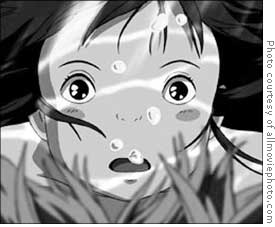
| << Front page | Arts | April 6, 2007 |
Anime Fanbase Increases on Oberlin Campus
 |
||
| Spirited Away: Anime films are becoming more mainstream. | ||
Anime, based on the Japanese comic book form called “manga,” is a highly stylized form of animation created in Japan after World War II. Brought to the States in the early 1960s, the complex form has recently experienced resurgence on this side of the Pacific. It’s been a growing phenomenon in the United States since the mid-nineties, with old childhood favorites like Dragon Ball Z giving way to such former cult hits as Cowboy Bebop, a series now shown on Cartoon Network.
There’s something for everyone, apparently, and many folks are jumping on the bandwagon. Despite isolation of Northern Ohio, the phenomenon has managed to reach Oberlin and thrive on campus.
Aside from the Cartoon Network, other networks such as the Disney Channel and the former WB have been programming cartoon series produced and created in the United States, which steal and incorporate distinctive elements of the anime style.
It’s no longer just Pokémon, for those of you still living in 1997 — today, it’s the disparate forms of Hayao Miyazaki (beautifully animated movies, ostensibly for children but beloved by almost everyone who sees them), Cowboy Bebop (bounty hunters and jazzy space-battles in the far future) and Inuyasha (a popular “adventure romantic comedy” involving demons, time travel, and a sacred jewel).
A large number of animes, categorized as “shonen,” consist of what Anime Club president College senior Andy Bartholomew characterizes as “the stereotypical boy-action show.” But there are many, many genres, including the “shojo” category of anime, which Bartholomew calls “anime for girls,” involving stories of high school romance and interpersonal dramas.
“There are so many genres that it appeals to many people,” Bartholomew said.
Other genres range from romance, drama and comedy to erotica, fantasy, science fiction and horror. There’s also a complex mixture of genres in many animes, so that an action-themed anime may have an underlying social commentary or a side story of romantic comedy.
What today comprises Oberlin’s Anime Club began six years ago as an offshoot from the popular ExCo course taught by Mike Lyon, OC ’01. To keep anime’s influence alive on this campus, devotees revived an old club charter from the mid-eighties and recreated the club in 2001.
The group holds showings of popular anime series, as well as the occasional marathon, usually in King. Approximately every other semester the club also teaches an ExCo.
Aside from the club’s activities, how present is anime on this campus?
“Many people watch it on their computers in their room,” according to Bartholomew.
The relatively new popular use of file-sharing tools such as Direct Connect and Kazaa allow students to find and download anime to watch whenever they please. While file-sharing is illegal, fans often post new favorites or esoteric series on websites such as www.animesuki.com or browse information about new developments in the anime world through sites like www.animenewsnetwork.com.
So who is watching all this anime? Could everyone you know be a closeted fan?
“I think it’s one of those things that just nerds do — Oberlin has a lot of nerds and geeks, so it’s pretty popular here,” Bartholomew said. “We also have a good East Asian Studies department, and many people get into Japanese studies by watching anime. I like to think that people get into Japanese culture through anime, and then go on to study more things about Japan.”
It seems that while not more than a few of us could talk at great length about Escaflowne — a series about a teenage girl with “psychic magic powers” who is transported to an enchanted world and becomes involved in a complex love triangle with an exiled prince with his own extensive back story, and a young, gallant knight — most everyone has heard of the famed Japanese animator Hayao Miyazaki. Miyazaki’s well-known anime, Spirited Away won an Oscar in 2003 for best animated film.
“Oh, everyone loves Miyazaki,” Bartholomew said.
As for more esoteric animes, he noted that “there are plenty of people who, while they wouldn’t call themselves big fans, would probably say they like a series or two.” Bartholomew insisted.
As for now, Bartholomew estimates an average of 10 to 25 people come to the weekly showings.
“It’s not hugely popular, but there are always those people who go to all of them.”
As for the future of anime on this campus, Bartholomew predicts that “it will slowly become one of those things that everyone is interested in. Anime, in general, is getting more popular, and I think it will become more ubiquitous [on this campus.]”
About us
Subscriptions
Advertising